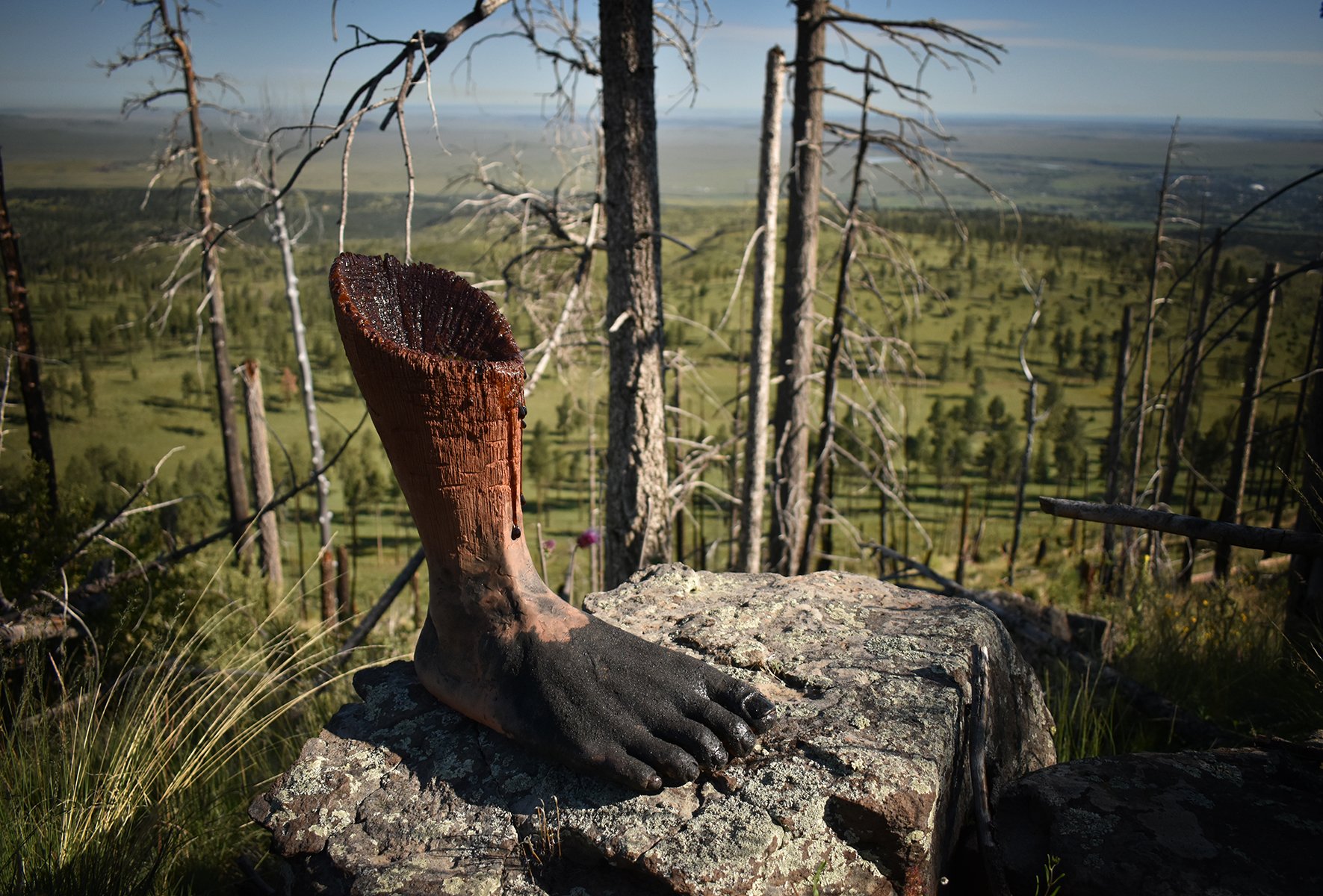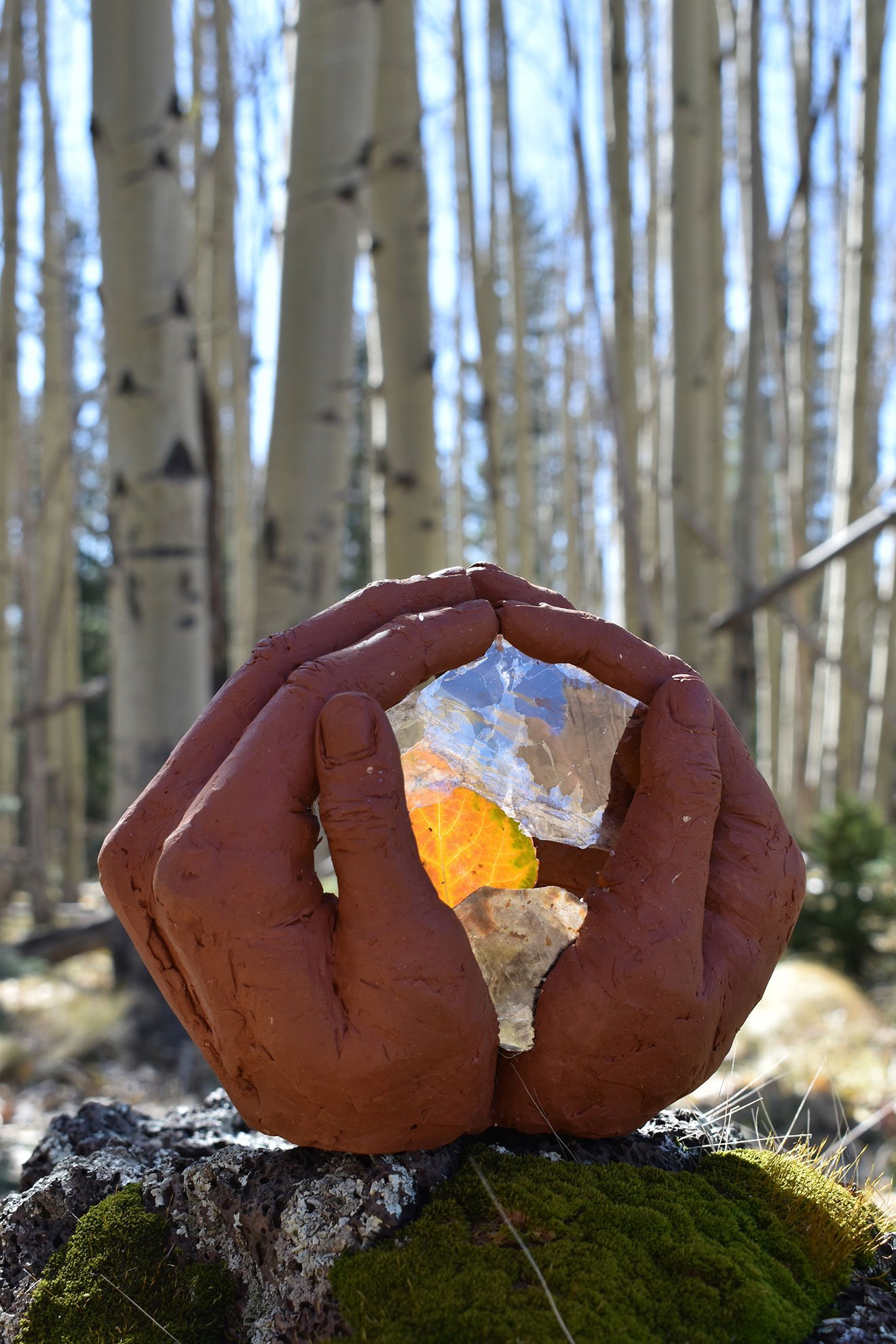-
I have always been drawn to the natural world and wanted to connect my artistic process more directly to that source of inspiration. It's undeniable that we are experiencing major shifts in our climate that affect the world around us. I think about this constantly and how it relates to my making process and what I am saying in my artwork. With consideration for my own environmental impact, I've decided to create sculptures from clay that will be recycled, rather than fired in a kiln. Abandoning the concept of permanence in the physical objects I create has allowed me to let go of my attachment to them and accept their fragility and inevitable change. It has also led to a greater sense of freedom in how I combine clay with impermanent materials as well as where and how I document these pieces. Taking these works out into the natural environments that inspired them adds a new dimension to how they can be presented. Elements like time, sound, and light have been playing a greater role in my aesthetic process. These ephemeral artworks are part of an on-going experiment that asks me to reconsider a material I have worked with for decades within an ever-changing landscape.
-
The outstretched arm of this figure is implanted with pine needles and seed heads to communicate feelings of prickliness and a bit of absurdity. Cinders tumbling from the back of its head reference instability and the passage of time, while the facial expression reveals feelings of discomfort and anxiety. I struggled with thinking about what should rest in the hand. Someone pointed out to me that the pine needles read as grass, growing on an arm that had been extended in space for an unbearable length of time. That helped me decide to leave the hand empty. I think that during these "uncertain times," we're all feeling the strain of trying to protect something. My something might be different from your something, but I feel the same strain, the same fear of change.
-
Regardless of how many seasons I live through, I find myself most resistant to change at the same time each year. When the late autumn honey-light filters through golden aspen leaves, I want to hold onto it with everything I have in me. This time, I boiled pine pitch into a thick amber syrup, candying the color and preserving it for just a little bit longer.
-
In 2011 the largest wildfire in Arizona state history raged across the White Mountains of Northeastern Arizona, burning over 500,000 acres. It made global news. I heard about it while traveling overseas, one month before I moved across the country, to the White Mountains. There are friends of mine who still won't hike in certain areas scarred by this burn because the memory of what was lost is too painful. In many ways, I feel protected by my ignorance; I don't really know what I'm missing. I hike through burn scars often, many of them from the Wallow Fire.
It's hard for me to feel just one way about these areas. In one sense, they are open and barren; the wind shrieks through the skeletons of still-standing dead trees. Logs crisscross in piles like matchsticks. When the sun beats down overhead I can feel the absence of a shady canopy. On the other hand, these areas are fascinating. There are countless abstracted sculptural monoliths suspended on seemingly impossible bases, the width of my wrist. I push on them, and they never move, frozen in time. The variety in texture and form of burnt wood ranges from molten sap bubbles to what I think of as pixelated explosions. Some of it shimmers and sparkles in ways that I can't quite capture photographically. I didn't know that there could be so much depth in blackness.
I often think of water when I pass through these scars. The water that could have been used to put out the campfire that was left to burn and change this area forever. The incredibly dry conditions that allowed a small spark to turn into a raging force of destructive heat. The snowcap and rainfall that is needed each year in this area to make the delicately balanced environment feel "normal." During a relatively wet summer, like the one we had this year, I breathe more easily. I can take comfort in the lime green leaves on the finger-thin baby aspen, rising up between charred stumps. Shimmering grasses and vibrant bursts of wildflowers punctuate the meadows with scarlet, violet and gold. It's a playground for chittering chipmunks and turquoise-colored pleasing fungus beetles. Pincushions of emerald green moss stud the shimmering black crevices of charred logs. If I take the time to notice these precious things, maybe I'll be a little more receptive to the types of sweeping change that I'm sure to experience in this landscape.
-
When making Rose-Colored and Red-Handed, I asked myself how one warm hue can be used to indicate such opposite things. Rosiness signals warmth, comfort, optimism, and a sense of well-being, while red-handedness indicates heat, anger and guilt. In creating a warm hue for this sculpture, I chose to use cochineal, a parasitic insect that feeds on prickly pear cacti. It has been sourced for centuries to create bright red dye, used traditionally on fiber and more recently in food and makeup. With mixed feelings and a bit of revulsion, I scraped the insects from a cactus in my yard, processed, dried and saved them. After being crushed and rehydrated, a bright magenta liquid was produced. I fully expected it to maintain this lovely color, but almost instantly, as I painted it onto the dry clay of my sculpture, it was absorbed and faded to a dusty lavender. The process of applying it had an almost hypnotic effect, watching the bright magenta flatten each time, like a light going out. The unexpected change in color and my mixed feelings about harvesting these bugs felt appropriately related to the concept I was investigating in this piece.
I've been noticing two very polarized approaches in coming to terms with accountability for how we affect the world around us. In one, we tend to see our actions as directly responsible for all that is perceived as negative in our environment, the result being that we hold ourselves in a perpetual state of guilt. On the flip side, we paint a rosy picture of the world for ourselves, embracing optimism and a denial of our ability to affect anything around us. In this case, we claim a lack of control over our actions because they relate to a divine plan that exists outside the grasp of our understanding. Neither one of these approaches leads to a full-spectrum look at the world around us because each is firmly rooted in a conclusion instead of admitting that there might be more than one way of seeing things. There might be more than one solution. There might not be a solution. Seeking a solution might not be the point. Both of these ways of looking at the world stem from an insular and intense focus on ourselves. We embrace our guilt or absolution, but don't move beyond either one. What would we see if we zoomed out of our headspace and looked more closely at the world without overanalyzing it? There are chances that we would see things that challenge both of these points of view. That might be uncomfortable, and we don't like to live in uncomfortable spaces.
This video is an artistic collaboration between Magda Gluszek and Ryan Orr. Magda created the sculpture (materials: unfired clay, cochineal. dimensions: 18" x 15" x 16") and videography.
Ryan wrote and performed the musical score.
-
Bend is a figure straining to compose herself in response to the landscape. Her stark lightness stands out against the red sandstone. Although I've been living in the southwest for over ten years, I am constantly reminded that this is not where I am from. Too much time in the sun and I end the day with a headache. Any uncovered skin flushes red from exposure. My lips crack and peel. As I hike through red-walled canyons, I encounter ancient architecture tucked away in secret recessed cliffs, chips of intricately painted pottery. Someone else's ancestors built them. Everywhere I turn, I experience something new, which is simultaneously what draws me in and reminds me that the novelty marks me as an outsider. What does it take to belong to a place?
-
Virga is rain that doesn’t reach the ground. It is a heartbreakingly beautiful display in the desert sky. Voluminous cotton-topped clouds hover, weighted down by gray-purple bellies, trailing wispy tails of precipitation. Sometimes it fills the sky with a mesmerizing backdrop of color and texture. Occasionally a single form is featured, cruising through a flat blue expanse, as if lost. I’m left standing on the parched ground, hoping that one filmy tendril will graze the earth and grace us with water.
-
Hold Time represents the fleeting moments in seasonal cycles that always feel as if they are slipping through my fingers far too quickly. The shift in color from lime green to lemon yellow and flame orange can take place over the span of weeks. Or, it can snuff itself out to charred brown in a cold snap overnight. The latter is what happened this year. I had one glorious day of moving through liquid yellow light. The sun passed through a million filters, as if through stained glass. Every year, I pick up little pieces of stunning compositions, scattered on the ground. I carry them with me. Sometimes I let them fall back, knowing that they would just fade on my kitchen table or turn to dust in the bottom of my backpack. This time I saved one, for a slightly longer moment.









































